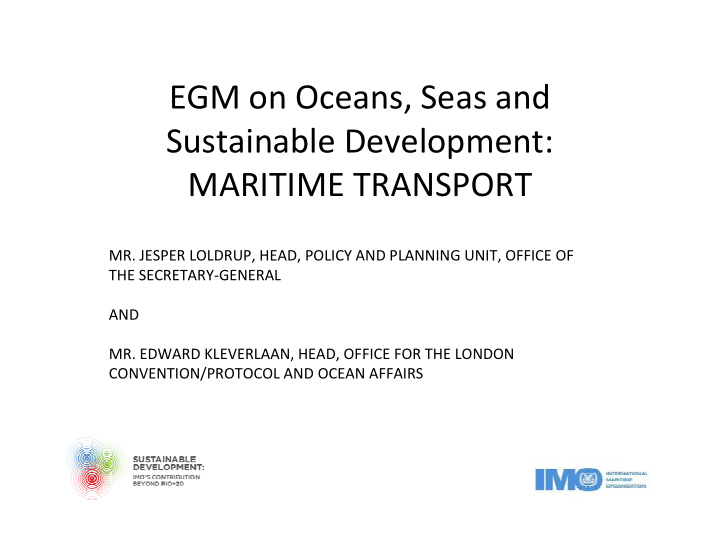



EGM on Oceans, Seas and Sustainable Development: MARITIME TRANSPORT MR. JESPER LOLDRUP, HEAD, POLICY AND PLANNING UNIT, OFFICE OF THE SECRETARY-GENERAL AND MR. EDWARD KLEVERLAAN, HEAD, OFFICE FOR THE LONDON CONVENTION/PROTOCOL AND OCEAN AFFAIRS
IMO “Safe, Secure and Efficient Shipping on Clean Oceans.” More than 90 per cent of global trade is carried by sea
Development of World Seaborne Trade
Maritime Transport Costs Shelf price Shipping costs TV set 1 unit $ 700.00 $ 10.00 DVD/CD player 1 unit $ 200.00 $ 1.50 $ 150.00 Vacuum cleaner 1 unit $ 1.00 Scotch Whisky Bottle $ 50.00 $ 0.15 Coffee 1kg $ 15.00 $ 0.15 Biscuits Tin $ 3.00 $ 0.05 Beer Can $ 1.00 $ 0.01
Largest Flag States 1. Panama 11. Italy 2. Liberia 12. Japan 3. Marshall Islands 13. United Kingdom 4. Hong Kong, China 14. Germany 5. Bahamas 15. Norway 6. Singapore 16. Republic of Korea 7. Greece 17. United States 8. Malta 18. Isle of Man 9. China 19. Denmark 10. Cyprus 20. Antigua and Barbuda
Sustainable Maritime Transport The Future We Want 133. We note that transportation and mobility are central to sustainable development. Sustainable transportation can enhance economic growth and improve accessibility. [….]
“I was very encouraged by the outcome document of the Conference, entitled “The Future We Want”. This contains a number of specific areas of relevance to this Organization and international maritime transport, in general. I have, therefore, established an internal mechanism within my Office, with support from all Divisions, to work with our industry partners and interested stakeholders on the development and implementation of Sustainable Development Goals for the maritime transport sector, which will be IMO’s own contribution to the United Nations led work on Sustainable Development Goals.” Secretary-General Koji Sekimizu Launch of the 2013 theme for World Maritime Day: “Sustainable Development: IMO’s contribution beyond Rio+20”
Pillars for sustainable maritime development Safety culture and Maritime security and anti- environmental stewardship piracy actions Energy efficiency Maritime traffic management New technology and Maritime infrastructure innovation development Maritime education and Global standards at IMO training
IMO and the Marine Environment IMO and Passenger Ship Safety The Future We Want 163. “…………..the health of oceans and marine biodiversity are negatively affected by marine pollution, including marine debris, especially plastic, ………….. We commit to take action to reduce the incidence and impacts of such pollution on marine ecosystems, including through the effective implementation of relevant conventions adopted in the framework of the International Maritime Organization (IMO), …[...]. Page � 9 Page � 9
The regulatory framework INTERPLAY SAFETY-ENVIRONMENT-PEOPLE and UNCLOS Safety requirements apply Provides the mandatory to all ships which are environmental protection subject to the Convention. level with zero discharge requirements in some areas. Legal framework Guidance and governing the rights and recommendations for responsibilities of nations training and competency in their use of ocean of officers and masters space. on ships. YOUR LOGO Page � 10 10
IMO and the Marine Environment IMO and Passenger Ship Safety 21 out of 53 international treaty instruments adopted by IMO so far are directly environmentally related In the marine environment, IMO deals with issues regarding: Shipping related pollution prevention and response (MARPOL, BWMC and OPRC) Dumping of Wastes and Other Matter (LC and LP) Page � 11 Page � 11
MARPOL Annexes MARPOL Annexes Annexes Annex Annex Annex Annex I & II III IV V VI Harmful Oil and Noxious Substances Carried Sewage from Garbage from Air Pollution from Liquid Substances at Sea in Packaged Ships Ships Ships Form In Force In Force In Force In Force In Force 152 Parties 138 Parties 131 Parties 145 Parties 72 Parties 99% of World 97% of World 89% of World 98% of World 94% of World Tonnage Tonnage Tonnage Tonnage Tonnage Not quite universal – but getting there! 12
CO 2 Emissions from International Shipping Source: 2 nd IMO GHG study, 2009
Air pollution and Green house gas emissions activities • MARPOL Annex VI • Focuses on technical and operational measures, improving energy efficiency design and management and in future market based measures (carbon pricing?) • First ever global legally binding CO 2 standard for an industry sector adopted at IMO in July 2011 – (EIF 1 January 2013)
Preparedness for and Response to Pollution Incidents • OPRC 1990 (OPRC-HNS Protocol, 2010) • 104 States; 71% tonnage • Incidents and amounts entering environment further reduced over time
INVASIVE MARINE SPECIES IMO and Passenger Ship Safety 164. We note the significant threat that alien invasive species pose to marine ecosystems and resources and commit to implement measures to prevent the introduction, and manage the adverse environmental impacts, of alien invasive species, including, as appropriate, those adopted in the framework of IMO. Oil Pollution Impacts Marine Bio- Invasions Time Page � 16 Page � 16
Shipping related activities Reducing the transfer of harmful aquatic organisms and pathogens by ships • Ballast Water Management Convention, 2004 (36 States, 30% tonnage) • A first set of international recommendations to address biofouling of ships were adopted in 2011, with a possible new mandatory instrument (or amendment) in the future.
Mandatory Polar Code Gain in distance: around 3,900 to 4,500 nm in both cases Source: www.grida.no YOUR LOGO Page � 18 18
Mandatory Polar Code Current geographical boundaries Arctic/Antarctic under consideration YOUR LOGO Page � 19 19
MARPOL requirements and response Prevention of oil pollution in polar regions and zero discharges (Antarctic) • Use and carriage of heavy grade oil � Oil spill response in ice and snow conditions YOUR LOGO Page � 20 20
London Convention and Protocol London Convention and Protocol Greenhouse gas (CO 2 ) and Ocean Greenhouse gas (CO 2 ) and Ocean Acidification Acidification Leadership: •Regulating new technologies : o Carbon capture and sequestration in sub- seabed geological formations o Geoengineering 21
Thank you for listening. www.imo.org YOUR LOGO Page � 22 22
Recommend
More recommend